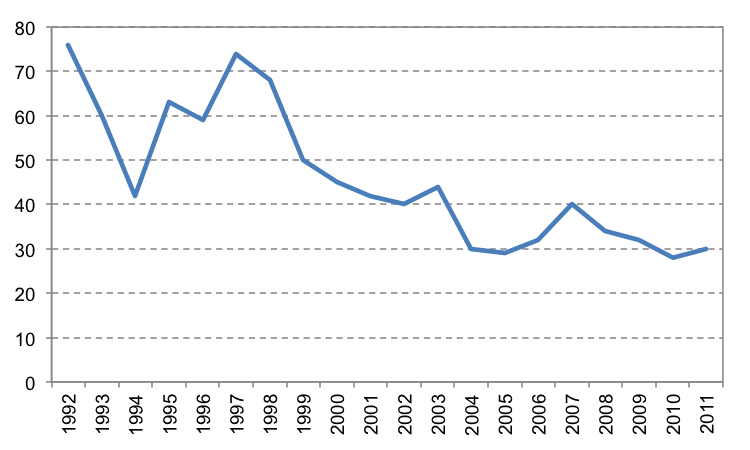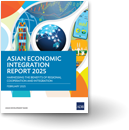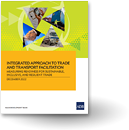The People’s Republic of China cracks electronic export sophistication: Fact or fallacy?
To the world, the People’s Republic of China (PRC) holds the enviable position as the largest exporter of electronic goods. To the PRC, electronics are not only the largest exports from the country, but they have done so consistently for more than a decade and have grown from strength to strength (Figure 1).
Figure 1: The PRC’s exports in HS-85 electronics. (US$, billion)
 Source: Authors’ calculation based on UN Comtrade data.
Source: Authors’ calculation based on UN Comtrade data.
The increased heft of the PRC and perceived high-tech nature of electronic goods raise two opposing implications. First, the PRC may be at the cusp of becoming a high-tech manufacturer that would spearhead its structural economic transformation beyond the “global factory” model. Second, developed economies which are leaders in advanced manufacturing may increasingly see the PRC as a direct competitor, which may worsen economic tensions leading to increased trade protectionism in the world.
Look closely, however, the facts do not corroborate with the view. The PRC does not appear to have raised its electronic export sophistication.
First, the PRC’s electronic exports are dominated by processing manufacturing, which is characterized by low-tech assembly activity. Although the share of processing exports in total electronics exports had declined marginally in recent years, it still represents the lion’s share of 70% (Figure 2). What’s noteworthy is that even this low level of sophistication cannot be attributed to domestic firms because more than 90% of the processing exports are run by foreign firms.
Figure 2: The share of processing exports and ordinary exports in total electronic exports (%)

Source: Authors’ calculation based on the PRC Customs data.
Second, electronic exports have low domestic value-added. The domestic content of electronic devices is very low at about 30%. For example, the domestic value added for computers was 33% in 2007, although this has improved from 20% in 2002. Still, for the much desired and sophisticated products such as smart phones, the domestic value added is very low—for iPhone 4, it is about 1.8%. In contrast, exports of knitted garments have 82% domestic content.
Third, the variety of electronic goods (extensive margin) exported has remained stable since 2007. While the value of electronic exports (intensive margin) has increased as shown in Figure 1, the variety or number of electronic goods exported has remained relatively unchanged since 2007 (Figure 3). This means the increase in exports is made up of a larger volume of a relatively unchanged number of differentiated products, which is more likely to suggest little or no improvement in export sophistication.
Figure 3: Number of electronic products exported at 6-digit HS-85.

Note: The marked decline in 2007 is likely due to the change in HS classifications from the 2002 to the 2007 series.
Source: Authors’ calculation based on UN Comtrade data.
Fourth, more important, coupled with the decline in unit value of many exported items (Figure 4), the stable extensive margin bodes ill with export sophistication. Newer and more sophisticated products command a price premium, but this does not seem evident from the PRC’s electronic exports.
Figure 4: Unit value of selected electronic exports at 6-digit HS-85 ($) 
Note: 850131 denotes DC motors, DC generators, of an output < 750 watts. 850132 denotes DC motors, DC generators, of an output 0.75-75 kW, and 850140 denotes AC motors, single-phase, not elsewhere specified. The overall trend for other 6-digit items in HS-85 also follow a similar pattern.
Source: Authors’ calculation based on UN Comtrade data.
Fifth, another yardstick is the decline in the number of exported electronic goods with higher unit value than the number of imported electronic goods—which in essence shows a decline in the terms of trade of electronics—an indication of a decline in competitiveness (Figure 5).
Figure 5: The number of goods with higher unit value for electronic exports than imports at 6-digit HS-85

Source: Authors’ calculation based on UN Comtrade data.
Taken together, the evidence suggests it is a fallacy to think that the PRC has grown in export sophistication particularly in its largest product segment of electronics. This evidence also lends support to the assessment that the country’s indigenous innovation policy has not properly capitalized on the reality of the real-world practice of global technology sourcing.
Clearly the country’s efforts to move up the value chain as recently outlined in 18th Communist Party of the People’s Republic of China National Congress Report underscores the recognition that cheap labor, an attractive exchange rate, and preferential policies to attract foreign direct investment, can no longer be relied upon to drive exports and sustained economic growth. The evidence presented here reinforces this urgency.




